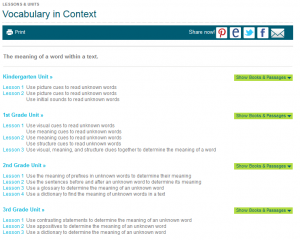Common Core Reading Lessons: Vocabulary in Context
 The meaning of a word within a text.
The meaning of a word within a text.
Vocabulary in Context Lessons - Covers kindergarten through sixth grade. Examples: Use picture cues to read unknown words. Use visual, meaning, and structure clues together to determine the meaning of a word. Use a dictionary to find the meaning of unknown words in a text. Use appositives to determine the meaning of an unknown word. Use multiple strategies to determine the meaning of a word in context.
Phonological Awareness
CCSS.ELA-Literacy.RF.K.2 Demonstrate understanding of spoken words, syllables, and sounds (phonemes).
CCSS.ELA-Literacy.RF.K.2b Count, pronounce, blend, and segment syllables in spoken words.
CCSS.ELA-Literacy.RF.K.2d Isolate and pronounce the initial, medial vowel, and final sounds (phonemes) in three-phoneme (consonent-vowel-consonent, or CVC) words. (This does not include CVCs ending with /l/, /r/, or /x/.)
Fluency
CCSS.ELA-Literacy.RF.1.4 Read with sufficient accuracy and fluency to support comprehension.
CCSS.ELA-Literacy.RF.1.4c Use context to confirm or self-correct word recognition and understanding, rereading as necessary.
Vocabulary Acquisition and Use
CCSS.ELA-Literacy.L.1.4 Determine or clarify the meaning of unknown and multiple-meaning words and phrases based on grade 1 reading and content, choosing flexibly from an array of strategies.
CCSS.ELA-Literacy.L.1.4a Use sentence-level context as a clue to the meaning of a word or phrase.
Print Concepts
CCSS.ELA-Literacy.RF.1.1 Demonstrate understanding of the organization and basic features of print.
CCSS.ELA-Literacy.RF.1.1a Recognize the distinguishing features of a sentence (e.g., first word, capitalization, ending punctuation).
Vocabulary Acquisition and Use
CCSS.ELA-Literacy.L.1.4 Determine or clarify the meaning of unknown and multiple-meaning words and phrases based on grade 1 reading and content, choosing flexibly from an array of strategies.
CCSS.ELA-Literacy.L.1.4a Use sentence-level context as a clue to the meaning of a word or phrase.
CCSS.ELA-Literacy.L.1.5 With guidance and support from adults, demonstrate understanding of word relationships and nuances in word meanings.
CCSS.ELA-Literacy.L.1.5c Identify real-life connections between words and their use (e.g., note places at home that are cozy).
Phonics and Word Recognition
CCSS.ELA-Literacy.RF.2.3 Know and apply grade-level phonics and word analysis skills in decoding words.
CCSS.ELA-Literacy.RF.2.3d Decode words with common prefixes and suffixes.
Vocabulary Acquisition and Use
CCSS.ELA-Literacy.L.2.4 Determine or clarify the meaning of unknown and multiple-meaning words and phrases based on grade 2 reading and content, choosing flexibly from an array of strategies.
CCSS.ELA-Literacy.L.2.4b Determine the meaning of the new word formed when a known prefix is added to a known word (e.g., happy/unhappy, tell/retell).
CCSS.ELA-Literacy.L.2.4e Use glossaries and beginning dictionaries, both print and digital, to determine or clarify the meaning of words and phrases.
Fluency
CCSS.ELA-Literacy.RF.3.4 Read with sufficient accuracy and fluency to support comprehension.
CCSS.ELA-Literacy.RF.3.4c Use context to confirm or self-correct word recognition and understanding, rereading as necessary.
Vocabulary Acquisition and Use
CCSS.ELA-Literacy.L.3.4 Determine or clarify the meaning of unknown and multiple-meaning word and phrases based on grade 3 reading and content, choosing flexibly from a range of strategies.
CCSS.ELA-Literacy.L.3.4a Use sentence-level context as a clue to the meaning of a word or phrase.
CCSS.ELA-Literacy.L.3.5 Demonstrate understanding of word relationships and nuances in word meanings.
CCSS.ELA-Literacy.L.3.5b Identify real-life connections between words and their use (e.g., describe people who are friendly or helpful).
CCSS.ELA-Literacy.L.3.6 Acquire and use accurately grade-appropriate conversational, general academic, and domain-specific words and phrases, including those that signal spatial and temporal relationships (e.g., After dinner that night we went looking for them).
Key Ideas and Details
CCSS.ELA-Literacy.RI.3.1 Ask and answer questions to demonstrate understanding of a text, referring explicitly to the text as the basis for the answers.
CCSS.ELA-Literacy.RI.3.2 Determine the main idea of a text; recount the key details and explain how they support the main idea.
Craft and Structure
CCSS.ELA-Literacy.RI.3.4 Determine the meaning of general academic and domain-specific words and phrases in a text relevant to a grade 3 topic or subject area.
Range of Reading and Level of Text Complexity
CCSS.ELA-Literacy.RI.3.10 By the end of the year, read and comprehend informational texts, including history/social studies, science, and technical texts, at the high end of the grades 2-3 text complexity band independently and proficiently.
Comprehension and Collaboration
CCSS.ELA-Literacy.SL.3.2 Determine the main ideas and supporting details of a text read aloud or information presented in diverse media and formats, including visually, quantitatively, and orally.
Fluency
CCSS.ELA-Literacy.RF.4.4 Read with sufficient accuracy and fluency to support comprehension.
CCSS.ELA-Literacy.RF.4.4c Use context to confirm or self-correct word recognition and understanding, rereading as necessary.
Vocabulary Acquisition and Use
CCSS.ELA-Literacy.L.4.4 Determine or clarify the meaning of unknown and multiple-meaning words and phrases based on grade 4 reading and content, choosing flexibly from a range of strategies.
CCSS.ELA-Literacy.L.4.4a Use context (e.g., definitions, examples, or restatements in text) as a clue to the meaning of a word or phrase.
CCSS.ELA-Literacy.L.4.4c Consult reference materials (e.g., dictionaries, glossaries, thesauruses), both print and digital, to find the pronunciation and determine or clarify the precise meaning of key words and phrases.